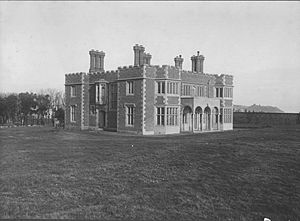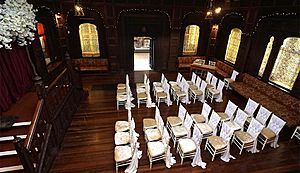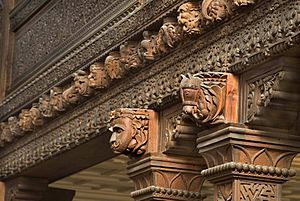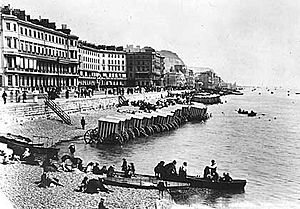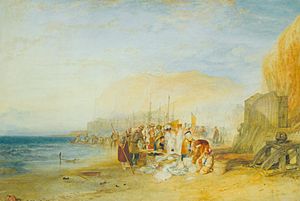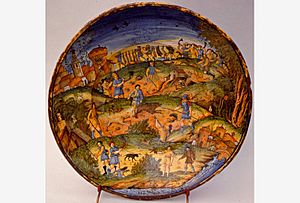Hastings Museum and Art Gallery facts for kids
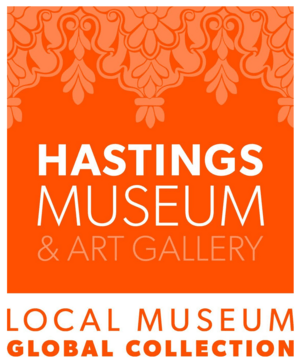 |
|
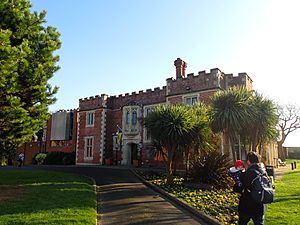 |
|
| Lua error in Module:Location_map at line 420: attempt to index field 'wikibase' (a nil value). | |
| Established | 1892 |
|---|---|
| Location | John's Place, Bohemia Road, Hastings, East Sussex, England TN34 1ET |
| Type | Regional museum, art gallery, history museum, decorative arts museum, natural history museum, local museum, archaeological museum, Asian art museum, ethnographic museum |
| Public transit access | Visiting the museum |
Hastings Museum & Art Gallery is a cool place in Hastings, East Sussex, England, where you can explore history and art. It first opened in 1892. The museum was originally in the Brassey Institute, which is now the town's library. In 1927, it moved to its current home.
As of 2019, the museum had about 97,000 items. These items cover local history, nature, beautiful art, decorative objects, and cultures from all over the world. You can see how the Hastings area changed from prehistoric times to the Saxon period. There are also displays of local wildlife in special scenes called dioramas. Plus, there's a fun dinosaur gallery! You can also learn about Archibald Belaney, a conservationist born in Hastings who became known as "Grey Owl."
Contents
- The Museum Building: A Historic Home
- Museum Collections: A World of Objects
- Community History: Hastings' Story
- Archives: Old Papers and Photos
- World Cultures: Objects from Around the Globe
- Archaeology: Digging Up the Past
- Numismatics: Coins and Medals
- Natural History: Local Wildlife and More
- Geology: Rocks and Dinosaurs
- Fine Art: Paintings and Sculptures
- Decorative Art: Beautiful Objects
- Costume and Textiles: Clothes Through Time
The Museum Building: A Historic Home
The museum has been located at John's Place since 1928. This building was first designed in 1923 as a private house. It is made of red brick with special sandstone decorations. The building looks unique with its castle-like roof, a covered walkway with columns, and cool oak doors.
Hastings Corporation bought the house and turned it into the museum in 1928. In 1932, they added an extension. This new part created an art gallery and housed the amazing Durbar Hall. The Durbar Hall was originally part of an Indian palace built for a big exhibition in 1886. In 1988, a storage area was added to the back of the building.
A major update happened between 2006 and 2007. This project was funded by the Heritage Lottery Fund. It made the museum 40% bigger and improved how people could get around. It also added better ways to control the temperature and humidity for the collections.
The Durbar Hall: A Palace Piece
The Durbar Hall was built for the 1886 Colonial & Indian Exhibition in London. It was a gift to the museum in 1919 as part of the Brassey Collection. This hall was the main part of the Indian Court at the exhibition. The court was designed to look like a traditional Indian palace.
Caspar Purdon Clarke designed the hall. It was built on-site by Mohammed Baksh and Mohammed Juma. These two were expert woodcarvers from Punjab, India. They came to London just to do the detailed wood carving for the exhibition. During the exhibition, the hall was the official reception area for the Prince of Wales.
After the exhibition, Thomas Brassey, 1st Earl Brassey bought parts of the Indian Court. He had them rebuilt as an extension to his house in London. Later, Thomas Allnutt Brassey, 2nd Earl Brassey moved it from London and gave it to Hastings in 1919. It was stored until the 1930s. Then, it was rebuilt at the museum to look like it did in the Brassey family's London home.
Today, the lower part of the hall is used for many events. These include talks, theater shows, and even weddings. The upper hall is now one of the museum's galleries, showing cultures from around the world.
Museum Collections: A World of Objects
The collections at Hastings Museum & Art Gallery started growing in 1890. That's when the Hastings and St Leonards Museum Association was created. The museum now has about 97,000 objects from all over the world.
Community History: Hastings' Story
The museum's community history collections tell the story of Hastings and the areas nearby. These objects, along with the archaeology and decorative art collections, show how Hastings has grown from the 1500s to today.
The local history collections include items about tourism, fishing, and boat building. You can also find things about smuggling, shipwrecks, and the Cinque Ports. There are items from local industries like ironworking and gunpowder making. The collection also has many photos, guide books, and items related to daily life. These include cooking tools, toys, games, and things about local theater, education, and transport. There are also items from the First and Second World Wars.
The museum has important collections about famous local people. These include John Logie Baird, Robert Tressell, James Burton, and Decimus Burton.
Archives: Old Papers and Photos
The museum has a large collection of old papers. These documents are about Hastings, the local area, and important people. They include papers from John Logie Baird, Robert Tressell, and Charles Dawson. There are also documents and books about the Cinque Ports, smuggling, and fishing. The archive has maps, photographs, and books.
The Burton Collection is also kept here. It has papers about James Burton, a property developer from London, and his son, Decimus Burton, who was an architect.
World Cultures: Objects from Around the Globe
Hastings Museum has many different collections from around the world. These include objects from India, China, Japan, Africa, Australia, and North America.
A big part of this collection was given in 1919 by the Brassey family. These items came from the personal museum of Anna Brassey (1839-1887). Lady Brassey loved collecting and photography. She gathered most of these items while traveling the world in the 1870s and 1880s. Many objects are from the Pacific and Melanesia. Other collections include stone carvings from Costa Rica and items from the Cook Islands.
The museum also has a large collection related to Native North Americans. This includes objects collected by local writer Clare Sheridan during her visit to America in 1937. The Blackmore Collection, given in 1982, mainly features items from the Plains Indians. The museum also has a large collection from Colin Taylor, with high-quality items from the Subarctic region. There's also a collection about Grey Owl, who was born in Hastings and adopted a Native American identity.
Archaeology: Digging Up the Past
The museum's archaeology collection has items found in Hastings and the surrounding area. There are also a few items from other parts of the world. The collection includes materials from most British historical periods.
You can see many flint tools from the Mesolithic to the Iron Age. These include flints found in Hastings Country Park. There are also good examples of Egyptian, Greek, and Roman pottery. Plus, there are a few pieces from ancient South America, New Zealand, and other places.
Numismatics: Coins and Medals
The numismatics collection shows coins from the Roman period up to the 20th century. There are good examples from the Saxon period, including coins made in Hastings. The collection also has over 700 local hop tokens and other trade tokens. You can also see commemorative medals and campaign medals.
Natural History: Local Wildlife and More
The museum's vertebrates collection mainly focuses on birds found locally in the early 20th century. This includes examples of the Hastings Rarities. There are also a few examples of larger mammals and fish. The Entomology and Invertebrates collections include butterflies, moths, other insects, shells, corals, and sponges.
Geology: Rocks and Dinosaurs
The geology collection has plant and animal fossils from the local area. This includes collections from Teilhard de Chardin, Philip Rufford, and Samuel Beckles. Hastings has long been famous for Iguanodon remains. The collection has many dinosaur fossils, including footprints from the Cretaceous rocks at Fairlight and Galley Hill.
Fine Art: Paintings and Sculptures
The museum's fine art collection mostly has paintings, drawings, prints, and photos of Hastings and the surrounding area. Many of these artworks are from the late 18th century to today. The museum also has a smaller collection of 20th-century British art and examples from major European art schools. There is also a small collection of sculptures by local artists. You can see the museum's oil paintings and sculptures on the Art UK website.
Decorative Art: Beautiful Objects
The museum's decorative art collections include ceramics, furniture, silverware, and jewelry. The largest and most important is the ceramics collection. It has a wide range of pieces, from ancient times to modern studio works. It includes rare items like the large maiolica piece known as the Modena Dish. The collections also have a good selection of Sussex pottery.
The furniture collection is smaller. It includes many fine examples of Sussex firebacks from the 16th to the 18th centuries. There are also a number of clocks and watches from the 18th and 19th centuries.
Costume and Textiles: Clothes Through Time
The costume and textiles collection includes various local clothes. These include smocks, waistcoats, women's and children's clothing, lace, and embroidered pieces. There is also a good collection of English, French, and German dolls.


